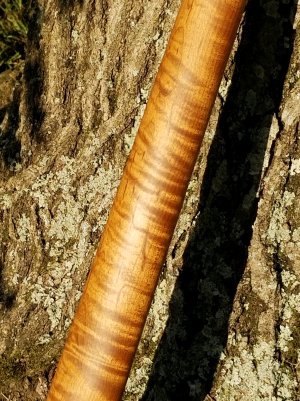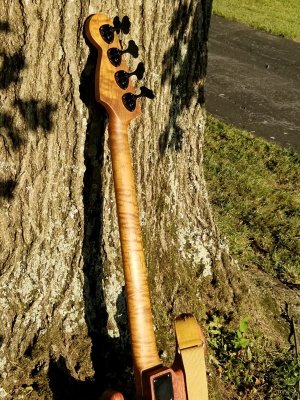Megatron
Junior Member
- Messages
- 92
Been enjoying my first Warmoth build so much that I decided I wanted another, but this time with a flamed maple top. I opted to buy used, and found a very high grade tele body in excellent condition. It's an absolute beaut and I'll post to the just out of the box/work in progress threads when I have pics handy.
I'd heard mention of chatoyance from Warmoth via the shop's YT channel as well as on this forum, and it seems that generally some very high grade flame tops just don't sparkle. I've also noticed that Warmoth flamed maple necks are very chatoyant (at least, from videos online) to the point where the "flames" can totally disappear and reappear from different angles.
My new Warmoth high grade flame top is modestly chatoyant - it's there, but nowhere near the effect that I can see on my gibson LP, which has a low-grade B+ top at best that is nitro-finished.
I wanted to get the forum members' opinions: Does this have anything to do with the thick gloss finish that Warmoth applies?
When I look at the control knob routes on my new tele body, I can see 1mm of finish encasing the body - it's quite substantial. Is it possible that the thick clear gloss coat is affecting the polarization or refraction of light such that it diminishes this cat's eye effect? Would a satin finish (or a simple stain finish with nitro spray) increase chatoyance in high grade flame tops? I appreciate that most builders don't want to work with nitro anymore, but is there a reason for such a thick coat of gloss poly?
Thanks!
I'd heard mention of chatoyance from Warmoth via the shop's YT channel as well as on this forum, and it seems that generally some very high grade flame tops just don't sparkle. I've also noticed that Warmoth flamed maple necks are very chatoyant (at least, from videos online) to the point where the "flames" can totally disappear and reappear from different angles.
My new Warmoth high grade flame top is modestly chatoyant - it's there, but nowhere near the effect that I can see on my gibson LP, which has a low-grade B+ top at best that is nitro-finished.
I wanted to get the forum members' opinions: Does this have anything to do with the thick gloss finish that Warmoth applies?
When I look at the control knob routes on my new tele body, I can see 1mm of finish encasing the body - it's quite substantial. Is it possible that the thick clear gloss coat is affecting the polarization or refraction of light such that it diminishes this cat's eye effect? Would a satin finish (or a simple stain finish with nitro spray) increase chatoyance in high grade flame tops? I appreciate that most builders don't want to work with nitro anymore, but is there a reason for such a thick coat of gloss poly?
Thanks!




